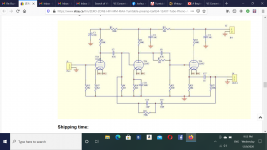I just traded some speakers for a nice-looking EAR 834P MM phono preamp clone. The trader was upfront about the buzzing noise it has. He tried some grounding fixes, but nada.
All I have done thus far is re-soldered the ground plug wire back to the chassis (he had cut it).
It is a nice sounding and looking unit (other than the buzz!), so I would really like to get this diagnosed and try and fix it.
The trader thinks it is a faulty component. I don't have equipment or training to check caps and resistors, etc, except for my digital multimeter.
Does anyone feel like taking pity on me and try to help me sort this out?
The "brand" is Zero Zone, and they have a schematic for one channel posted on their eBay page:

All I have done thus far is re-soldered the ground plug wire back to the chassis (he had cut it).
It is a nice sounding and looking unit (other than the buzz!), so I would really like to get this diagnosed and try and fix it.
The trader thinks it is a faulty component. I don't have equipment or training to check caps and resistors, etc, except for my digital multimeter.
Does anyone feel like taking pity on me and try to help me sort this out?
The "brand" is Zero Zone, and they have a schematic for one channel posted on their eBay page:

834 clone
I have built one of these clones. Mine is dead quite. Build a power supply with 3 chokes, one common for both channels and two "small" ones, 6oH/8mA, in a dual mono . Each channel has its own B+.
Regulated 12v for the heaters. Remember to "earth/ground" signal eart/ground, near the input.
I have built one of these clones. Mine is dead quite. Build a power supply with 3 chokes, one common for both channels and two "small" ones, 6oH/8mA, in a dual mono . Each channel has its own B+.
Regulated 12v for the heaters. Remember to "earth/ground" signal eart/ground, near the input.
If it was a kit, then it is possible that the construction is the source of the buzz. In which case some pictures would be helpful, so connections to ground can be identified, and cables and their routing.
I took photos, but couldn't upload them. I think I have to resize them and make them smaller. Will post them soon.
QUESTION: Should ground wires attach from the input wire to the chassis, via the neutral line? The input wire is attached normally, but there are two cut wires coming out of some electrical tape (have not removed the tape yet).
QUESTION: Should ground wires attach from the input wire to the chassis, via the neutral line? The input wire is attached normally, but there are two cut wires coming out of some electrical tape (have not removed the tape yet).
Caution!
Neutral and Ground are not the same thing.
Many modern power mains have either Ground, Neutral, Hot;
or Ground, Hot phase 1, and Hot phase 2.
Prevent "Surviving Spouse Syndrome"
Obey the local safety codes of your country.
Do not tie grounds and neutral together.
Safety First.
And, connecting ground and neutral together will also create a Hum ground loop.
I hope you are using 3 wire power mains outlets, and a 3 wire power cords to your preamp and power amp.
To reduce ground loops, connect turntable, preamp, and power amp all to the same multi-outlet 3 wire power strip.
Turntables are usually 2 wire, not 3 wire.
Preamps often are 2 wire (but even if they are, again, do not connect ground and neutral together).
Neutral and Ground are not the same thing.
Many modern power mains have either Ground, Neutral, Hot;
or Ground, Hot phase 1, and Hot phase 2.
Prevent "Surviving Spouse Syndrome"
Obey the local safety codes of your country.
Do not tie grounds and neutral together.
Safety First.
And, connecting ground and neutral together will also create a Hum ground loop.
I hope you are using 3 wire power mains outlets, and a 3 wire power cords to your preamp and power amp.
To reduce ground loops, connect turntable, preamp, and power amp all to the same multi-outlet 3 wire power strip.
Turntables are usually 2 wire, not 3 wire.
Preamps often are 2 wire (but even if they are, again, do not connect ground and neutral together).
Last edited:
Supposed to be a great sounding circuit. I hope you can straighten it out quickly.
I’ve noticed is that some sellers offer a basic board for the 834p audio section only, but you can alternately get a more expensive board that adds a power supply section with solid state rectifiers and regulating components (?) Does your pcb include that part? If not, what psu design is used?
My basic troubleshooting process would lead me to check if the buzz is the same on both channels. Does tube swapping make any difference? Removing tubes? How about shorting the inputs? Suggests power supply supply when both channels have the same issues no matter what. ++ to observing all safety protocols of course 🙂
I’ve noticed is that some sellers offer a basic board for the 834p audio section only, but you can alternately get a more expensive board that adds a power supply section with solid state rectifiers and regulating components (?) Does your pcb include that part? If not, what psu design is used?
My basic troubleshooting process would lead me to check if the buzz is the same on both channels. Does tube swapping make any difference? Removing tubes? How about shorting the inputs? Suggests power supply supply when both channels have the same issues no matter what. ++ to observing all safety protocols of course 🙂
- Home
- Amplifiers
- Tubes / Valves
- Ear 834 phono pre clone, loud buzzing, newbie